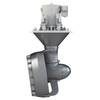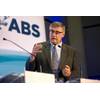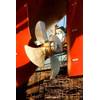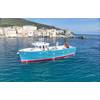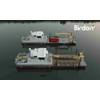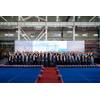LNG Gains Traction as Alternative Fuel
As Cargo, Fuel or both; LNG is emerging as the clear and clean way forward for the maritime industry.
• In the Beginning
The use of LNG as a marine fuel is not new. Vessels trading cryogenic LNG have burned boil-off natural gas in steam boilers for many years as a simple solution to maintaining necessary temperatures and pressures within cargo spaces. The use of the fuel varied according to the size of the ship and a boil off rate ranging between 0.10 to 0.18 percent of the total cargo.
As a result of the variable quantities, gas was not considered a “primary” fuel and the provision of standard heavy fuel oil tanks remained with ship construction. That mindset, construction practice and the pro forma use of heavy fuel oils may soon change. Like the rapid warming that allows shipping in heretofore unheard of Arctic routes, LNG’s considerable utility is also about to be unfrozen.
• Warming Up to New Possibilities
The boil off loss of LNG cargo and its economic impact eventually led to the development of new re-liquefying technology. Smaller simpler systems installed onboard that allowed the gas boil off to be returned to a liquid state and eventually sold as cargo. This new technology in turn drove shipbuilders to consider two stroke and four stroke diesel engines as the ship’s prime movers. These diesel engines were more fuel efficient than steam boilers and were additionally capable of operating on smaller amounts of available boil off gas.
In particular, engine manufacturer Wärtsilä recognized the coming changes and developed a slow speed dual-fuel 7RNMD90 engine in 1973 for the LNG carrier “Venator”. They followed with high-pressure, two-stroke gas engines in 1986 for marine use and introduced their first medium-speed high-pressure gas engines targeted for land-based markets during the same timeframe.
The move to gas was not a stretch for internal combustion engines. Many shoreside power plants throughout the United States and Europe have adopted the technology and utilized the fuel to meet strict stack emission requirements set by the U.S. Environmental Protection Agency (EPA) and the European Environmental Agency (EEA). Power utilities are now reconsidering natural gas as a stable power source in a sector that has been historically served by coal and nuclear power. As gas slowly conquers its two largest issues – volatile price fluctuations and questionable supply – coal struggles with emission issues and nuclear power has come under a new wave of attacks as a result of the fallout in Japan. All of these variables may positively affect LNG’s expansion into new marine propulsion sectors.
• Supply, Demand and Infrastructure, too
New discoveries abroad along with development of shale gas in the United States have solved the supply issue. Domestic shale gas resources have doubled in two years to 827 trillion cubic feet, according to the DOE 2011 Annual Energy Outlook. Almost 500 trillion cubic feet more than 2010 estimates, this doubling of production could translate into a twenty percent increase in total natural gas by 2035 at prices below the 2010 reference case of about $4.50/mm btu. Emissions and technology aside, as crude oil prices continue to rise with instability in the Middle East, favorable natural gas pricing and an abundant supply will serve to bridge North America and Europe away from oil.
The construction of the LNG bridge has already started. North America (Canada and Mexico included) contains approximately thirteen LNG import terminals. Cheniere Energy Partners plans to add liquefaction capability to export LNG to their Sabine Pass plant by 2015. Freeport and Macquarie Energy have similar plans for liquid export at their Quintana Island facility. El Paso hopes to install LNG truck loading facilities at their Elba Island, GA import facility to serve a land-based market that has seen a national 18 percent increase in the bus, truck and rail markets. These export plans and distribution systems may well serve as a blueprint for new marine fuel distributions market in North America.
Small scale LNG distribution is gaining momentum in Europe. The Linde Group, a global gases and industrial engineering firm that produces and distributes cryogenic products in over one hundred countries, has established itself globally as a provider of unique LNG capabilities. These range from gas clean-up and liquefaction technologies for LNG production to on-ship re-liquefaction systems and storage tanks, with small-to-large scale LNG plants built on several continents. In March, Linde’s Scandinavian subsidiary AGA received its first load of LNG at their new import terminal in Sweden. The terminal supplies natural gas to a local refinery, Stockholm’s city grid and other local industries. It is also positioned to support the growing interest in LNG fueling by shortsea vessels and passenger ferries in the Baltic Sea. Linde is also participating in similar efforts in other geographies, including North America.
• Safety & Education: Not Fear
Not long ago, fear accompanied any discussion of transporting liquid natural gas in Northern Europe. The tales included potential terminal explosions wiping out entire cities and theories that an explosion in an offshore Livorno, Italy terminal would crumple the leaning tower of Pisa. In reality, natural gas is flammable; hence its utility as a viable fuel source. As a liquid in a cryogenic state, there is no danger of explosion and the fuel is stable. It simply cannot ignite. Beyond this, the ongoing establishment of small distribution networks of bunkering stations, barges and terminals to deliver marine LNG throughout Northern Europe has been somewhat effective in calming public fears. The fuel change in this area was necessary to meet IMO SECA and ECA emission standards established in the Baltic and North Sea as far back as 2005.
North America itself faces the same IMO ECA emission challenges in August of 2012. The effort to dispel irrational fears and the planning of infrastructure therefore must begin now. Despite reports from naysayers, neither issue is insurmountable. And, the decision of which fuel helps to meet the environmental restrictions looming large in the porthole seems simple enough. Those still unsure can watch an informative LNG video by clicking http://www.youtube.com/watch?v=xjYPb0M5S-Q.
Finally, environmental concerns over escaping methane due to misfire or problems in the combustion space, an issue called “methane slip,” is also causing renewed discussion in Europe. In fact, engine manufacturers have already addressed this issue with new piston ring development and injection timing and the technology advances daily.
• North America: Time to Catch Up
Why is the establishment of a North American LNG distribution network so important? A look at the growth of LNG propulsion and technology in Europe will reveal the answer. Over 100 vessels use the fuel for propulsion today, including vessels actually delivering LNG. The growth sector for the fuel in Northern Europe has been fueled by shortsea shipping, ferry services and offshore supply boats which involve (a.) shorter voyage itineraries and (b.) routing that transits areas where LNG bunkering services are available.
Engine manufacturer Wärtsilä has played a major part in the LNG expansion with nearly 60 vessels employing dual-fuel engines and over 1.5 million running hours of operation. These four-stroke engines employ technologies that provide low emissions and maximum fuel efficiency in several different engines sizes – the Wärtsilä 50DF, 34DF and 20DF. Their design influence does not stop at the engines. Wärtsilä also provides LNGPac, a complete LNG storage system with bunkering station, delivery controls, cold box compartment and glycol-water heating unit.
A turn-key design and manufacturing integration process is available to both owner and shipbuilder. The mix allows ship design ranging from large container or cruise ships to small harbor tugs and offshore supply vessels. Hence, the key to the future of LNG as a marine fuel resides in global availability, beyond short voyage itinerary and into every sector of bluewater shipping. America could play an important role in that development.
• Not Just Concepts: Viability
Det Norske Veritas (DNV) has certified more than 21 vessels now in service. Based upon their operational experience and safety records, DNV remains convinced that LNG is the fuel of the future – inside and well beyond IMO ECAs. The DNV Triality project introduces a VLCC concept that has the same operational range and capacities of existing VLCC tonnage. Three of the most likely trading routes include the U.S., China and Europe with all of those theoretical voyages starting in the Arabian Gulf.
The Triality design incorporates three environmental features; a ballast free and V-shaped hull design, a VOC re-condensation system and the prime element – LNG as fuel. Employing a 13,500 cubic meter LNG fuel tank with an operational range of 25,000 nautical miles, the design elements allow a 34 percent reduction in CO2 emissions. On the other hand, refueling Triality requires 270 truckloads of LNG. This minor drawback should encourage some spirited entrepreneur to visualize the huge business opportunities represented by LNG bunkering for the maritime trades.
• Cleaner Air Now: but at what cost?
The use of LNG alone reduces carbon emissions by approximately 25 percent, sulfur oxides (SOx) by nearly 100 percent, nitrogen oxides (NOx) by 85 percent and particulate matter by nearly 95 percent. The health and environmental issues seem simple enough, yet North American LNG development has fallen drastically behind that accomplished in Europe. The lack of interest begs the question: Is it possible to go “green” in the United States and be profitable? Both DNV and Wärtsilä believe the answer is yes. Others believe changes need to occur.
The real challenges revolve around public support, perception and unfounded rumor. For example, one prominent offshore oil service provider announced they had not considered LNG and dual fuel engines because the engines cost four times the price of existing Tier II equipment. Wärtsilä refutes that misinformation by asserting that LNG propulsion reaches well beyond the engine and into many other areas of the ship.
According to Wärtsilä, the total cost runs about 3-to-5 percent above existing new construction prices with the cost of the engines alone about 15 percent above current engines burning HFO. Do the environmental benefits outweigh the cost? In the case of DNV’s Triality concept and with LNG realistically priced at $12/mmbtu, the financial benefits compared to a base case VLCC running on HFO with exhaust scrubbers and ballast water treatment is about $20M over 20 years. The projected fuel cost savings over the life of the ship will more than pay for the investment.
• The Way Forward: history, logic – and need
The way forward in the United States, where coastal (shortsea) shipping is underdeveloped, will be difficult. The failure to utilize ferry or Ropax tonnage as extensively as the Europeans only exacerbates the problem. The LNG test platform has simply not been available and to reap the considerable environmental benefits that LNG provides, the fuel must be available here in North America. That said, the technology has advanced to a point where smaller, offshore oil support vessels, harbor tugs or ATBs can be competitively built in smaller, second tier shipyards in the United States. This is work that is surely needed in this economic environment.
One way to provide the necessary “spark” for LNG would be to create a “sunset waiver” or “pilot program” to build larger LNG powered RoRo, container feeder or small scale LNG distribution vessels in foreign yards, allowing U.S. coastwise privileges. That “spark” likely carries as much fear and debate as LNG itself – but 2012 and North America’s ECA requirements are just around the corner. The decision to proceed is best handled by learning from the Baltic & North Sea experience where LNG has been successfully employed as a marine fuel over the past 10 years. But, even that high standard has been eclipsed by the outstanding international safety record, spanning 50 years of handling and ocean transport of LNG. Clearly, it is time to “defrost LNG.” – MarPro.
(As published in the Q2 2011 edition of MaritimeProfessional)




